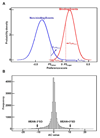Prioritizing single-nucleotide variations that potentially regulate alternative splicing
- PMID: 22373210
- PMCID: PMC3287877
- DOI: 10.1186/1753-6561-5-S9-S40
Prioritizing single-nucleotide variations that potentially regulate alternative splicing
Abstract
Recent evidence suggests that many complex diseases are caused by genetic variations that play regulatory roles in controlling gene expression. Most genetic studies focus on nonsynonymous variations that can alter the amino acid composition of a protein and are therefore believed to have the highest impact on phenotype. Synonymous variations, however, can also play important roles in disease pathogenesis by regulating pre-mRNA processing and translational control. In this study, we systematically survey the effects of single-nucleotide variations (SNVs) on binding affinity of RNA-binding proteins (RBPs). Among the 10,113 synonymous SNVs identified in 697 individuals in the 1,000 Genomes Project and distributed by Genetic Analysis Workshop 17 (GAW17), we identified 182 variations located in alternatively spliced exons that can significantly change the binding affinity of nine RBPs whose binding preferences on 7-mer RNA sequences were previously reported. We found that the minor allele frequencies of these variations are similar to those of nonsynonymous SNVs, suggesting that they are in fact functional. We propose a workflow to identify phenotype-associated regulatory SNVs that might affect alternative splicing from exome-sequencing-derived genetic variations. Based on the affecting SNVs on the quantitative traits simulated in GAW17, we further identified two and four functional SNVs that are predicted to be involved in alternative splicing regulation in traits Q1 and Q2, respectively.
Figures




Similar articles
-
Changes in predicted protein disorder tendency may contribute to disease risk.BMC Genomics. 2011 Dec 23;12 Suppl 5(Suppl 5):S2. doi: 10.1186/1471-2164-12-S5-S2. Epub 2011 Dec 23. BMC Genomics. 2011. PMID: 22369681 Free PMC article.
-
Alternative splicing modulated by genetic variants demonstrates accelerated evolution regulated by highly conserved proteins.Genome Res. 2016 Apr;26(4):440-50. doi: 10.1101/gr.193359.115. Epub 2016 Feb 17. Genome Res. 2016. PMID: 26888265 Free PMC article.
-
Alternative splicing and genetic diversity: silencers are more frequently modified by SNVs associated with alternative exon/intron borders.Nucleic Acids Res. 2011 Jul;39(12):4942-8. doi: 10.1093/nar/gkr081. Epub 2011 Mar 11. Nucleic Acids Res. 2011. PMID: 21398627 Free PMC article.
-
Rules and tools to predict the splicing effects of exonic and intronic mutations.Wiley Interdiscip Rev RNA. 2018 Jan;9(1). doi: 10.1002/wrna.1451. Epub 2017 Sep 26. Wiley Interdiscip Rev RNA. 2018. PMID: 28949076 Review.
-
Biomedical impact of splicing mutations revealed through exome sequencing.Mol Med. 2012 Mar 30;18(1):314-9. doi: 10.2119/molmed.2011.00126. Mol Med. 2012. PMID: 22160217 Free PMC article. Review.
Cited by
-
The Silent Sway of Splicing by Synonymous Substitutions.J Biol Chem. 2015 Nov 13;290(46):27700-11. doi: 10.1074/jbc.M115.684035. Epub 2015 Sep 30. J Biol Chem. 2015. PMID: 26424794 Free PMC article.
-
Impact of human pathogenic micro-insertions and micro-deletions on post-transcriptional regulation.Hum Mol Genet. 2014 Jun 1;23(11):3024-34. doi: 10.1093/hmg/ddu019. Epub 2014 Jan 16. Hum Mol Genet. 2014. PMID: 24436305 Free PMC article.
-
regSNPs-splicing: a tool for prioritizing synonymous single-nucleotide substitution.Hum Genet. 2017 Sep;136(9):1279-1289. doi: 10.1007/s00439-017-1783-x. Epub 2017 Apr 8. Hum Genet. 2017. PMID: 28391525 Free PMC article.
-
Analysis of exome sequences with and without incorporating prior biological knowledge.Genet Epidemiol. 2011;35 Suppl 1(Suppl 1):S48-55. doi: 10.1002/gepi.20649. Genet Epidemiol. 2011. PMID: 22128058 Free PMC article.
-
A method to incorporate prior information into score test for genetic association studies.BMC Bioinformatics. 2014 Jan 22;15:24. doi: 10.1186/1471-2105-15-24. BMC Bioinformatics. 2014. PMID: 24450486 Free PMC article.
References
Grants and funding
LinkOut - more resources
Full Text Sources
Miscellaneous

